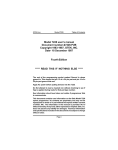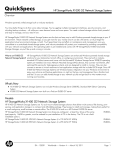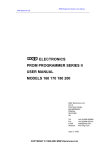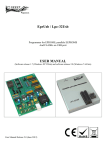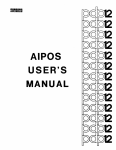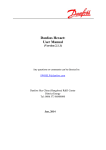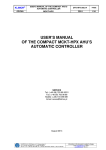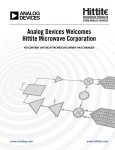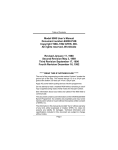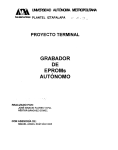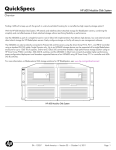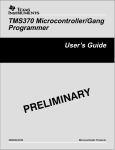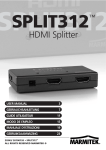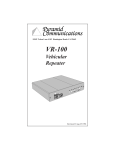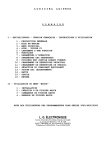Download Model 7128 user`s manual Document number &7128.PUB Copyright
Transcript
GTEK, Inc. Model 7128 Table of Contents Model 7128 user’s manual Document number &7128.PUB Copyright 1983-1987, GTEK, INC. —Revised— 24 January 1988 Fourth Edition ***** READ THIS IF NOTHING ELSE ***** The end of the programming socket marked Ground is where ground is. This means that pin 12 of a 24 pin part and pin 14 of a 28 pin part goes at this end. Apply AC power before putting devices into the 7128. Do Not attempt to read a masked rom without checking to see if Vpp is applied during reads for that part type number. See information about baud rates and cables if programmer fails to communicate. This document contains user information on the Gtek Model 7128 eprom programmer. Its contents are proprietary and may not be reproduced in whole or in part without the express written consent of GTEK, INC. The information in this manual is provided "As Is" without warranty of any kind, either expressed or implied. GTEK, Inc. does not assume any liability for damages. Technical information and specifications included in this document are subject to change without notice. Page i Table of Contents Model 7128 —Notes— Page ii GTEK, Inc. GTEK, Inc. Model 7128 Table of Contents Table of Contents I Introduction . . . . . . . . . . . . . . . . . . . . . . . . . 1 II Commands . . . . . . . . . . . . . . . . . . . . . . . . . 3 P Program block . . . . : Intel hex program . . . S Motorola hex program R Read Block . . . . . . OI Intel hex Output . . . OM Motorola hex Output . L List formatted Output . V Verify Erasure . . . . . M Menu . . . . . . . . . T Toggle command set . TC Compare . . . . . TS Split . . . . . . . TB Byte . . . . . . . TN Checksum . . . . TZ Zap . . . . . . . . ’ ’ Space . . . . . . . . . I Identify device . . . . X Return Version Number $ Abort Character . . . III . . . . . . . . . . . . . . . . . . . . . . . . . . . . . . . . . . . . . . . . . . . . . . . . . . . . . . . . . . . . . . . . . . . . . . . . . . . . . . . . . . . . . . . . . . . . . . . . . . . . . . . . . . . . . . . . . . . . . . . . . . . . . . . . . . . . . . . . . . . . . . . . . . . . . . . . . . . . . . . . . . . . . . . . . . . . . . . . . . . . . . . . . . . . . . . . . . . . . . . . . . . . . . . . . . . . . . . . . . . . . . . . . . . . . . . . . . . . . . . . . . . . . . . . . . . . . . . . . . . . . . . . . . . . . . . . . . . . . . . . . . . . .3 .3 .4 .4 .5 .5 .5 .6 .6 .7 .7 .8 .8 .8 .9 .9 .9 .9 .9 Diagnostics . . . . . . . . . . . . . . . . . . . . . . . . 11 General . . . . . . . . . . . . . . . . . . . . . . . . . 11 Error Codes . . . . . . . . . . . . . . . . . . . . . . . 11 IV Interfacing Notes . . . . . . . . . . . . . . . . . . . . . 13 Programming Flowchart Figure 4.1 V . . . . . . . . . . 14 Automation Hints . . . . . . . . . . . . . . . . . . . . . 15 Page iii Table of Contents VI Model 7128 GTEK, Inc. Specifications . . . . . . . . . . . . . . . . . . . . . . . 17 Programmer Interface . . . . . . . . . . . . . . . . . 18 Making a Cable . . . . . . . . . . . . . . . . . . . . . 18 VII Hex Formats . . . . . . . . . . . . . . . . . . . . . . . 21 Intel Format . . . . . . . . . . . . . . . Data Record . . . . . . . . . . . . End Record . . . . . . . . . . . . . Extended Address Record . . . . . Start Address Record . . . . . . . Motorola Format . . . . . . . . . . . . Comment Record . . . . . . . . . Data Records . . . . . . . . . . . . End Record . . . . . . . . . . . . . Tektronix Format . . . . . . . . . . . . Data Blocks . . . . . . . . . . . . . Termination Block . . . . . . . . . Abort Block . . . . . . . . . . . . . Example of Data/Abort block . . . Example of Data /Termination block VIII PGMX7 . . . . . . . . . . . . . . . . . . . . . . . . . . . . . . . . . . . . . . . . . . . . . . . . . . . . . . . . . . . . . . . . . . . . . . . . . . . . . . . . . . . . . . . . . . . . . . . . . . . . . . . . . . . . . . . . . . . . . . . . 21 21 21 21 22 23 23 23 24 25 25 25 25 26 26 . . . . . . . . . . . . . . . . . . . . . . . . . . 27 Installation . . . . . . . . . . Operation . . . . . . . . . . Example . . . . . . . . . . . Valid Options . . . . . . . . Example . . . . . . . . . . . Using Control F . . . . . . . Definitions . . . . . . . . . . Valid Commands for PGMX7 Example . . . . . . . . . . . Advanced Example . . . . . Batch file automation . . . . Other programs available . . . . . . . . . . . . . . Page iv . . . . . . . . . . . . . . . . . . . . . . . . . . . . . . . . . . . . . . . . . . . . . . . . . . . . . . . . . . . . . . . . . . . . . . . . . . . . . . . . . . . . . . . . . . . . . . . . . . . . . . . . . . . . . . . . . . . . . . . . . . . . . . . . . . . . . . . . . . . . . . . . . . . . . . . . . . . . 27 28 29 30 30 32 33 34 34 36 36 37 GTEK, Inc. Model 7128 Table of Contents IX GHEX.EXE . . . . . . . . . . . . . . . . . . . . . . . . 39 X DEBUG.COM . . . . . . . . . . . . . . . . . . . . . . . 41 XI Warranty and Service . . . . . . . . . . . . . . . . . . . 43 Limited Warranty . . . . . . . . . . . . . . . . . . . Service . . . . . . . . . . . . . . . . . . . . . . . . PGX, PGMX and PGMX Software License Agreement License . . . . . . . . . . . . . . . . . . . . . . . . Term . . . . . . . . . . . . . . . . . . . . . . . . . . PGX, PGMX and PGMX7 Limited Warranty . . . . . Limitations of Remedies . . . . . . . . . . . . . . . General . . . . . . . . . . . . . . . . . . . . . . . . A . . . . . . . . 43 44 44 44 45 45 46 47 Appendix . . . . . . . . . . . . . . . . . . . . . . . . . 49 Introduction . . . . . . . . . . . . . . . . . . . . . . . 49 General Rules . . . . . . . . . . . . . . . . . . . . . . 49 B Appendix Adapters . . . . . . . . . . . . . . . . . . . . . . . . . 51 C Appendix Manufacturer’s Cross Reference vs Menu Selection . . 53 D Appendix Manufacturer Trade Marks . . . . . . . . . . . . . . . 63 Page v Table of Contents Model 7128 —Notes— Page vi GTEK, Inc. GTEK, Inc. Model 7128 Chapter I INTRODUCTION Congratulations. You now have what we believe to be the most cost effective and advanced eprom programmer on the market today. The design philosophy used on the 7128 allows for simple future expansion of capabilities. All communications with the 7128 is in printable ASCII characters and it supports Intel, Motorola and Tektronix hex formats as well as simple block formats. Additionally, the 7128 supports the MCS-86 extended hex format, and Motorola’s S record format with features for automatically split programming two eproms for use in a true 16 bit data path. Resident features include facilities for making source to eprom content comparisons, erasure checks, formatted device listings, menu driven device selection, a Zap command for chip erasing EEPROMs, and more. The 7128’s interrupt driven type ahead buffer allows it to program and verify in real time, while data is being sent. The model 7128 programs and verifies in real time transparent to the user, whose sole responsibility is to send and receive data. The standard algorithm prereads cells prior to programming, skips the cell if it is not necessary to program it, and post verifies the cells to assure that it is properly programmed. Extended diagnostics pinpoint the cause of errors. The Model 7128 may be used with hardware CTS/DTR handshake. Baud rate selection is done automatically through your interface program, PGMX7. The 7128 defaults to 1200 baud on power-up. Used in conjunction with any terminal or computer with an RS-232 port, the 7128 is capable of programming and reading the devices listed in Appendix C of this manual. 40 pin devices require socket adapters. All voltages and pin configurations are set up by the onboard mpu and no personality modules are required. ROMs may be read safely only with certain eprom selections, such as i68766, F27C64 and 27C32. Page 1 Chapter I Model 7128 —Notes— Page 2 GTEK, Inc. GTEK, Inc. Model 7128 Chapter II COMMANDS P Program block Sending a ’P’, followed optionally by an ascii–hex address, and a valid delimiter puts the 7128 into the program mode. Once in the program mode, ascii–hex data to be programmed is sent. The data may be a continuous stream or the bytes (groups of two ascii–hex characters) may be separated by valid delimiters. The program mode is terminated upon the receipt of an ascii dollar sign, ’$’ or if an error occurs. Thus, the program command may be used to program one byte or a block of bytes at any given location. Valid delimiters are spaces, commas, carriage returns, line feeds, or dashes. It may be useful to note that the 7128 totally ignores null characters. All characters sent are echoed as they are removed from the input FIFO (type ahead buffer). Xon, and Xoff characters are never put into the FIFO. The following example illustrates how 33h and 23h are programmed to locations 444h and 445h in a 2716: Example: 2716> P444-33 23$ 2716> _ [ready for next command] : Intel hex program When in the command state, receipt of a colon is interpreted as the lead character in an Intel hex record. The 7128 automatically enters the program mode and programs the data contained in the hex record at the address specified in the header of the hex record. The check sum is verified at the end of the hex record and the 7128 then returns to the command state but does not reissue the command prompter unless the record happened to be the END record. This is done in anticipation of another hex record, i.e., all characters from the hex file, sent to the Model 7128 will be echoed back to the user with no additions or deletions. See the section on toggles and hex formats for clarification on how to program two devices for device use on a true 16 bit data bus. The segment base address register, maintained by the 7128, is Page 3 Chapter II Model 7128 GTEK, Inc. automatically cleared if a programming error occurs, the end record is detected, or if any other command is executed other than the Intel Hex command. S Motorola hex program This command functions precisely the same way that the Intel hex program command does, except the format is the Motorola S record format. Records may be of type S0, S1, S2, S3 OR S9. R Read Block The R command, followed optionally by beginning and ending addresses, causes the Model 7128 to output a continuous string of ascii–hex characters between the specified addresses. If no addresses are specified, the 7128 will output the entire contents of the selected device. The R command may be aborted at any time by sending a dollar sign, ’$’, to the programmer. The following uses the eprom programmed in the example of the P command. Example: 2716> R444,445< cr> 3323 2716> _ [terminated by cr,lf, followed by prompt] Note: The R command is primarily for automated reading of eproms. If you execute the command line as shown in the above example, you will find that the data output over writes the command line unless your terminal is in an auto line feed mode. Example: 3323> R444,445< cr> 2716> _ Page 4 GTEK, Inc. Model 7128 Chapter II OI Intel hex Output The OI command has the same command syntax as the R command. It differs in that the 7128 will output the device contents as an Intel hex file, including the end record, between the specified addresses or if no addresses are specified, the entire device. Again, the command may be aborted if desired with a dollar sign, ’$’. OM Motorola hex Output The OM command functions precisely the same way the OI command does, except that the file output is in the Motorola S record format. L List formatted Output The L command outputs the data, between optionally specified addresses, in a formatted fashion similar to many dump utilities. If no addresses are specified, the entire contents will be listed and the command may be aborted with the dollar sign, ’$’. Each line of the listing includes the beginning address in ascii–hex, sixteen data bytes in ascii–hex and the ascii representation of the data. Non printable bytes are replaced with periods in the ascii representation field. Example: 2716> L90,AF< cr> 0090 4845 4C4C 4FFF // FFAB 99FF H E L L O . // . . . . 00A0 FFFF FFFF FFDD // FFFF FFFF . . . . . . // . . . . 2716>_ [prompter indicates end of command] Note: The lines are shortened at the "//" to allow printing on this page. Unlike the R, OI, and OM commands, the L command will output a carriage return and line feed at the beginning of the listing. This is because the L command is primarily used when the host is functioning as a terminal and it would be irritating to have the first line of the listing overwrite the command line. V Verify Erasure The V command checks the cells between the optionally specified addresses for erasure, FF’s or 00’s as the device type dictates. If no addresses are specified, the entire device is checked. If a Page 5 Chapter II Model 7128 GTEK, Inc. non-erased cell is encountered, its contents and address are output. The process continues until the end address is reached or the command is aborted with a dollar sign, ’$’. The following example uses the same eprom used in the P and R command examples. Example: 2716> V<cr> 33 @ 0444 23 @ 0445 2716>_ Note the command verifies the whole selected part because boundaries were not specified. The command outputs a crlf before each unerased byte is displayed so the command line is not overwritten. A new prompter indicates end of command. M Menu The Menu command is used to select the device type you intend to work with. The current device type always becomes part of the command prompter. Sending an M<cr> causes a menu to be output, from which the desired device is then selected. If the code letter for the device is already known, then just send M<code> and the device will be selected. Selecting a device establishes the programming algorithm to be used, as well as the device pinout, proper programming voltage and prompter. Menu Command Examples follow: xxxx> MD 2732A>_ Note that a cr,lf and new prompt are output subsequent to sending the code letter D which selects the 2732A device type. Page 6 GTEK, Inc. Model 7128 2732A> M<cr> EPROMSELECTIONMENU NMOS NMOS CMOS A– 2758 G– 2508 N– MC6716 B– 2716 H– 2516 L– 27C16 C– 2732 I– 2532 5– 27C16H D– 2732A J– 2564 M–27C32 E– 2764 K– 68766 6– 27C32H 1– 2764A 2– 27128A O– F27C64 F– 27128 Z– 27256 Enter Selection –>E 2764>TI i2764>_ Chapter II EEPROM P– 5213 Q– X2816A X– 48016 Y– I2816A W/ADAPT R– 874x–1K S– 874x–2K T– 874xH–1K U– 874xH–2K V– 8751 W–8755 You must give the 7128 a device type on power up before attempting to perform any commands other than Menu. An *SL ERR will be generated if this is not done. xxxx> _ [default command prompter for V3.26] See the selection chart in the appendix to select parts that are not on the 7128’s menu but can be programmed using this programmer. T Toggle command set. The toggle command is used as a prefix to a subset of commands. These commands are as follows: TC Compare The TC toggle command is used to turn the compare mode on and off. When in the compare mode, the command prompter is prefixed by a lower case c. The compare mode is used to compare the contents of a device against that of a source file. To use the compare mode, use the TC toggle to turn on the compare mode. Then use one of the various programming commands as if you were going to program the device. Instead of programming the device, the 7128 will make a comparison of the source byte to the contents of the device. If they are not the same, a comparison error will be issued and the 7128 will return to the command state. Page 7 Chapter II Model 7128 GTEK, Inc. See Diagnostics Section for details. Example: 2764A> TC c2764A> _ TS Split The TS toggle puts the 7128 into a split mode used for programming two eproms whose intended destination is for use in a true 16 bit data path environment. While in the split mode, the command prompter is prefixed by either a lower case h or l indicating high (Odd Address) byte or low (Even Address) byte respectively. It should be noted, that if a programming error occurs while in the split mode, that the address of the error given by the 7128 will be the address within the eprom being programmed, not the address in the hex file. See TB command. TB Byte The TB command is used in conjunction with the split mode, TS, to target the selected device for the high (ODD) bytes or low (EVEN) bytes from an Intel Hex or Motorola S record source file. TN Checksum The TN command is used to generate a 16 bit checksum from the data in the eprom. This is the sum of all the (8 bit) DATA bytes added together without carry. You may make a checksum between any two addresses by specifying them like the OI and V and the other commands that use a start and end address. TZ Zap The TZ command is the chip erase command used in conjunction with EEPROMS. The device is erased and erasure is verified. The UV error is issued in the event that the user attempts to execute the TZ command when the device is not capable of supporting it. The SEEQ 5213, Intel 2816A and Xicor X2816A (and others) are capable of modifying bytes randomly, Page 8 GTEK, Inc. Model 7128 Chapter II and Zapping is not necessary. The Hitachi 48016, however, does not have this feature. Thus, in order to reprogram a 48016, the chip erase (Zap) command must first be executed. ’ ’ Space Sending a space (ascii 32 char) to the programmer causes it to reissue the command prompter. I Identify device The Model 7128 will reissue the command prompter in the same way that the space command does. X Return Version Number The X command will return the version number of the firmware installed in the chip shown as follows: 2716> X GTEK,INC. Model 7128 Vx.xx Copyright 1987 2716>_ $ Abort Character. Causes the operation in progress to abort to the command prompter when received dur ing operations of the OI, OM, OT, R, P, L, V, U. Refer to those commands for further information. Page 9 Chapter II Model 7128 —Notes— Page 10 GTEK, Inc. GTEK, Inc. Model 7128 Chapter III DIAGNOSTICS General 1. All error codes to be issued by the Model 7128 are preceded by an asterisk, ’*’. This makes error trapping very easy. 2. After an error occurs and the error mes sage is output, the input FIFO is cleared and the programmer returns to the command state. 3. Errors are output on a real time basis, i.e., they are output as soon as they are detected. 4. Error codes include the address, (nnnn), where the error occurred, except attempt to program on power up before selecting the eprom type (*SL err). Error Codes * WP ERR @nnnn– cell Won’t Program. Eprom is no good or the wrong device type was selected or the device was improperly inserted, in which case, it may or may not be any good now !! * NE ERR @nnnn– cell Needs Erasing. Can’t program the cell because there are some bits that can’t be moved from a 0 to a 1 state. * CP ERR @nnnn– ComPare error. Issued in the event of a difference between source code and destination contents of target device. See TC command. * DT ERR @nnnn– DaTa error. Not valid hex data. Character is not a 0 through 9 or A through F or CR or LF. * CS ERR @nnnn– CheckSum error. Data check sum does not add up to what was sent in the HEX record. Only applies to Intel and Motorola hex format program commands. Page 11 Chapter III Model 7128 GTEK, Inc. * SN ERR @nnnn– SyNtax error. Not a valid programmer command. See commands. * SL ERR @nnnn– SeLect error. No such menu code, or if no "@nnnn" present, you tried to program after power up without selecting an eprom type. * ST ERR @nnnn– STack error. FIFO overflow. Reduce baud rate or see interfacing section for handshaking methods. The 7128 version 3.26 can take data at 300 bps with no handshake on any algorithm. * UV ERR @nnnn– Un-aVailable error. Issued in the event the user tries to use a function of the 7128 that is not available for that particular device, such as the Zap command on the I2816. Page 12 GTEK, Inc. Model 7128 Chapter IV INTERFACING NOTES The Model 7128 is surprisingly easy to interface and there are several methods of handshaking which can be utilized if it is desired to operate at the higher baud rates. The following section describes some of the methods. 1–Software handshake. This is perhaps the easiest method of all. When you begin to send data to be programmed, send the first byte but don’t wait for it to be echoed. That would effectively cut your communication rate in half. Instead, send the second byte, receive the first, send the third byte, receive the second, etc. This technique will allow you to program as fast as the algorithm in use permits. Some devices program faster, some slower! See figure 4.1 for flowchart. 2–CTS/DTR hardware handshaking. The Model 7128 is configured as data terminal equipment, which means that the CTS (clear to send) line is an input to the programmmer which when pulled low forces the programmer to stop sending. On the other hand, the DTR (data terminal ready) line is an output from the programmer. DTR will go low when the buffer is about 50% full and high again when the buffer is about 30% full. If you are using hardware hand shake and the DTR line goes low, you should stop sending Immediately to the 7128. The RTS line is pulled high whenever the programmer is plugged in. See Specifications for Cable. 3–Xon/Xoff software handshaking. If you do not monitor the DTR line, the 7128 will transmit an Xoff character if there gets to be 9 characters in the FIFO. When the FIFO level drops below 6 characters, an Xon will be transmitted. Likewise, when the programmer is sending you data, you may send an XOFF character, which will stop the programmer from sending until it receives an Xon character. Xon’s and Xoff’s, are not put into the FIFO, but are processed as soon as they are re ceived. Even if you don’t use XON/XOFF handshaking, you will find it useful when using the L, list command, to stop and start the data flow to your screen. Xon and Xoff are the keyboard equivalents of control-Q and control-S. Page 13 Chapter IV Model 7128 GTEK, Inc. 4–Please note that the 7128 may communicate at several different baud rates. To initialize to a new baud rate, send a space character to the programmer at the baud rate you wish to begin sending. After that, a space command will cause the prompter to be reissued. Figure 4.1 Flo wc hart showing a programming example. start open file get character send character get character char is eof is char = eof? char is not eof send character receive character is char * ? display character not an asterisk char is an asterisk display character receive character char is not > or is eof display character is char > ? end Page 14 char is not a > GTEK, Inc. Model 7128 Chapter V AUTOMATION HINTS When you automate the transfer of data from your computer to the 7128, you should examine the echoed characters to see if an asterisk, "*" has been sent. If you receive one, it means that an error message will follow and that the programmer will return to the command state. Any automation software should take this into account. The effective addressing range of a device is determined by it’s size. If a 2K byte device is being used, then it only has 11 significant address lines and only the lowest 11 bits of the address field are significant. Thus, as far as the 7128 is concerned, 000H is equivalent to 800H or F000H in a 2K device. You don’t need to compare the characters that are echoed to what you sent. The characters are echoed to the host as they are removed from the FIFO, and would not reflect a programming error. However, the 7128 will detect any programming error and the host need only trap the error message. The PGX utilities for CP/M and MSDOS based computers send echoed characters to the screen (console). PGMX7, due to its high baud rates, does not attempt to display all the information being transferred, unless the "D" option has been specified. The 7128 is in the command state after the prompter is sent. The prompter always ends with a ’>’. You can use this character to let your program know that an R, OI, OM, OT, V, or L command has finished. You should probably have one mode of operation where you communicate directly with the 7128 (turn your computer into a terminal). This will give you easy use of the L, V, P, and M commands. Page 15 Chapter V Model 7128 —Notes— Page 16 GTEK, Inc. GTEK, Inc. Model 7128 SPECIFICATIONS Dimensions (H x W x D) 2.75 x 5.25 x 6.75" (70 x 133 x 171mm) Power Requirements 120VAC, 60HZ, 10VA (240VAC, 50HZ optional) Interface Connector DB25P configured as Data Terminal Equipment. Data word size 1 Start bit, 8 data, 1 stop bit, no parity Auto Select Baud Rate 110, 300, 600, 1200 Weight 3 pounds (1.4 KG) Page 17 Chapter VI Chapter VI Model 7128 GTEK, Inc. Operating Environment 45 - 95 deg F. (7 - 35 deg C.) 5% to 95% non-condensing relative humidity. Programmer Interface The model 7128 has a DB25P connector configured as Data Terminal Equipment (DTE). 7128: Pin# 1—(EG) 2—(TXD) 3—(RXD) 4—(RTS) Direction <—> —> <— —> 5—(CTS) <— 6—(DSR) 7—(SG) 20–(DTR) <— <—> —> Function Equipment Ground. Transmit Data. ReceiveData. Request To Send. Always active when power is on. Clear To Send. High enables 7128 to transmit data Pulled high internally. Data Set Ready. Not used. Signal Ground. Data Terminal Ready. High when programmer willing to accept data. Making a Cable Refer to the Specifications section for information on making a cable for other than an IBM PC. Page 18 GTEK, Inc. Model 7128 Chapter VI IBM PC/XT/AT DB25 (female) to 7128 (female– Gtek pn RSMDTE) The IBM’s and the 7128 both have MALE connectors on them. IBM — 7128 EG –1 — 1—EG TXD–2 — 3—RXD RXD–3 — 2—TXD CTS–5 —20—DTR SG—7 — 7—SG DTR–20 — 5—CTS DSR–6 — 4—RTS RTS–4 — 6— DSR 1 EG 1 EG 2 TXD 2 TXD 3 RXD 3 RXD 4 RTS 4 RTS 5 CTS 5 CTS 6 DSR 6 DSR 7 SG 7 SG 8 CD 8 CD 20 DTR 20 DTR 7128 Programmer (DTE) (female) IBM 25 pin or 25 pin DTE connector (female) Page 19 Chapter VI 1 EG Model 7128 GTEK, Inc. HOOK TO CABLE SHEILD 1 CD 2 TXD 2 RXD 3 RXD 3 TXD 4 RTS 4 DTR 5 CTS 5 SG 6 DSR 6 DSR 7 SG 7 RTS 8 CD 8 CTS 20 DTR (NC) 7128 Programmer (DTE) (female) IBM 9 pin or DTE 9 pin connector (female) AT DB9 (female) to 7128 DB25 (female) The AT and the 7128 both have a MALE connector. AT CD—1 RXD–2 TXD–3 DTR–4 SG—5 DSR–6 RTS–7 CTS–8 RD—9 9 RI — 7128 — 8—CD — 2—TXD — 3—RXD — 5—CTS — 7—SG — 4—RTS — 6—DSR —20—DTR — —NC Page 20 GTEK, Inc. Model 7128 Chapter VII HEX FORMATS Intel Format Data Record Byte Number 1 2—3 4—5 6—7 8—9 10—x x+1 — x+2 x+3 — x+4 Colon (:) Number of binary data bytes Load address, high byte Load address, low byte Record type Data bytes, 2 ASCII—HEX characters Checksum, two ASCII—HEX characters CR,LF End Record Byte Number 1 2—3 4—7 8—9 10 — 11 12 — 13 Colon (:) Record length, must be "00" Execution address Record type Check sum CR,LF Extended Address Record (MCS—86 hex format) Byte Number 1 2—3 4—7 8—9 10 — 13 14 — 15 16 — 17 Colon (:) Record length, should be "02" Load address field, should be "0000" Record type, must be "02" USBA Check sum CR,LF Page 21 Chapter VII Model 7128 GTEK, Inc. Start Address Record (MCS—86 hex format) Byte Number 1 2—3 4—7 8—9 10 — 13 14 — 17 18 — 19 20 — 21 Colon (:) Record length, "04" "0000" Record type, "03" 8086 CS value 8086 IP value Check sum CR, LF The checksum is the two’s compliment of the 8—bit sum, without carry, of all the data bytes, the two bytes in the load address, and the byte count. Page 22 GTEK, Inc. Model 7128 Chapter VII MOTOROLA FORMAT Comment Record Byte Number 1—2 3—n x+1 — x+2 "S0" Comment field CR,LF Data Records Byte Number 1—2 3—4 5—6 7—8 9—x x+1 — x+2 x+3 — x+4 "S1" Number of data bytes + 3. Load address, high byte. Load address, low byte. Data bytes, 2 characters each. Checksum. CR,LF. Byte Number 1—2 3—4 5 — 10 11 — x x+1 — x+2 x+3 — x+4 "S2" Number of data bytes + 4. (2 characters) Load address, 24 bits (6 characters) Data bytes, 2 characters each. Checksum (2 characters). CR,LF. Byte Number 1—2 3—4 5 — 12 13 — x x+1 — x+2 x+3 — x+4 "S3" Number of data bytes + 5. Load address, 32 bits (8 characters) Data bytes, 2 characters each. Checksum CR,LF. Page 23 Chapter VII Model 7128 GTEK, Inc. End Record Byte Number 1 — 2 "S9" 3 — 4 CR,LF. In the above S records, the byte count includes the load address and checksum. Thus the byte count is equal to the number of data bytes plus the following; 3 for S1, 4 for S2 and 5 for S3 type records. The checksum is the one’s compliment of the 8—bit sum, without carry, of the byte count, the two bytes of the load address, and the data bytes. Page 24 GTEK, Inc. Model 7128 Chapter VII TEKTRONIX HEX FORMAT (for reference only, not supported) Data Blocks Byte Number 1 2—5 6—7 8—9 10 — X X+1 — X+2 X+n Header (which is a forward slash— /) Location counter which is 4 ascii—hex characters representing the load address of the data bytes. Byte count which is 2 ascii hex bytes specifying the number of binary data bytes in the data field of the block. First Checksum, which is 2 ascii—hex bytes specifying the HEX SUM of the values of the previous six digits. (location counter and the byte count) Binary data bytes which are each represented as 2 ascii—hex digits. (in other words 16 binary bytes are represented as 32 ascii—hex bytes.) Second Checksum. 2 ascii—hex bytes representing the SUM, modulo 256 of the binary values of the ascii data bytes. (8 bit sum without carry.) Always a carriage return. (CR) Termination Block Byte Number 1 Header (forward slash /) 2 — 5 Transfer address which is the address for execution of code. 6 — 7 Byte count, always 00 for a termination block. 8 — 9 Checksum of the six digits that make up the transfer and byte count. 10 Always a carriage return. (CR) Page 25 Chapter VII Model 7128 GTEK, Inc. Abort Block Byte Number 1 2 3 — X+69 X+70 Header forward slash / Header forward slash / Message up to 69 characters for error information etc. Always a carriage return. (CR) Example of Data block and 1 Abort block /000010100102030405060708090A0B0C0D0E0F0038 //THIS IS AN ERROR MESSAGE HERE Note: programmer will issue a *DT error on the second "/" mark and return to the command state without displaying the abort message... Example... of Data block and 1 Termination block /000010100102030405060708090A0B0C0D0E0F0038 /00000000 NOTE: Most terminals will display Tektronix data only on one line, since the format calls for only a carriage return at the end of a record. This section on the Tektronix hex format is provided as a reference only since the 7128 cannot support this format directly. You should be able to convert this format to the Intel format or more easily to the binary format. Page 26 GTEK, Inc. Model 7128 Chapter VIII Using Interface Program PGMX7 Installation PGMX7 is a high speed communication program which runs on IBM PC/XT/AT’s. It allows flexible manipulation, transmission and reception of Intel HEX files and binary files. On the PGMX7 program disk you will have at least 3 programs: PGMX7.COM,PINSTAL7.COMandGHEX.EXE.PGMX7istheprogram used to communicate with your 7128. PINSTAL7 is the program that you must run to install the serial drivers in PGMX7 so that you can communicate with the 7128. Other programs and document files are provided to allow conversion from Motorola format to Intel hex and other programs to split and interleave to and from 8, 16 and 32 bit binary formats. If you try to run the PGMX7 program without installing the serial drivers, it will tell you to run the PINSTAL7 program. Remember that the PGMX7 license is a single user license. Insert GTEK program disk in drive A: and copy the programs to your hard disk with: C> COPY A:*.* This will copy all the programs on the GTEK disk over to the subdirectory that you are logged on to on your hard disk. If you don’t have a hard disk, use DISKCOPY or COPY to the B: drive. Refer to the DOS manual for specific instructions on using the COPY command. The desired end result is a backing up of the original GTEK copy. Store the original program disk in a safe place. Now you should insert the backup copy in the drive A: and/or go to the subdirectory where PINSTAL7 and PGMX7 are located. You must first run the PINSTAL7 program to install the serial drivers for PGMX7. C> PINSTAL7<cr> Page 27 Chapter VIII Model 7128 GTEK, Inc. After the copyright and version number appears, you are asked to select a letter which corresponds to the type of installation you wish to perform. Most people should install PGMX7 for 1200 baud. Remember on a 7128 the maximum baud rate is 1200. IRQ4 is used in conjunction with an interrupt service routine for COM1: when PGMX7 is invoked if you installed it for COM1:. This is a hardware line on your PC to give the system an interrupt whenever a character is received. If you know that something else in your computer is using this hardware interrupt line, then you should use the other com line, which uses IRQ3 (COM2:). IRQ3 is also used in the same manner for COM2: when PGMX7 is invoked if you installed it for COM2:. If you know something in your system uses IRQ3 for interrupts, then you must use the other com port. The next selection that you have to make is where your line printer is located, on parallel port 1, 2, or 3 (lpt1:, lpt2: or lpt3:). This has to be done so that PGMX7 knows where to send printed data. After you have made that last selection, you are returned to the DOS command prompter and PGMX7 is set up to run under those conditions that you specified. See the example for C>PGMX7<cr> later in the manual. Operation PGMX7 is a "command driven program" as opposed to a "MENU driven program" which means that everything you do is done by entering a "command" on the command line instead of "selecting" the command from a menu. This makes the program very fast when you have learned what the commands are. In most cases the commands are exactly the same command as what the programmer is expecting, so the selection of the command is somewhat intuitive. Page 28 GTEK, Inc. Model 7128 Chapter VIII There are 2 ways that commands may be given to PGMX: 1- From the PC or MS DOS command line. 2- From within PGMX7. Commands executed from DOS return to DOS upon completion. Commands executed from within PGMX7 return to PGMX7 upon completion. Command lines may be entered from within PGMX7 by depressing control F. Example C> PGMX7<cr> Enter PGMX7 and establish communication with the programmer (assuming everything is hooked up properly). C> PGMX7 filename<cr> Results in communication being established with the programmer and sending filename.hex (Intel Hex Format) from the disk to the programmer. When PGMX7 is through, you are returned to the DOS system prompt. C> PGMX7 filename [OPTIONS]<cr> Results in PGMX7 establishing communication with the programmer, and then performing according to selected options. Programming the eprom in binary or Intel Hex format or Reading the eprom in the same formats may be accomplished by giving the proper options. OPTIONS are always enclosed in square brackets and separated by comma’s. Invalid commands result in an appropriate and descriptive ERROR message. Page 29 Chapter VIII Model 7128 GTEK, Inc. Valid Options R %ooooo @sssss - eeeee Mx Tx Vsssss-eeeee D read file. (default is program mode) binary mode select (default is HEX) Eprom bounds menu selection toggle command (3 max on command line) verify erasure display data as it is being received from the 7128 Example PGMX<cr> from the DOS command line establishes communication with the 7128, and after log-on displays the 7128 Command Prompter, which is the currently selected eprom type. (remember these are examples and your display may not be exactly like this one!) C> pgmx7<cr> High Speed Interface Package Version 9.32 Copyright 1983, 1984, 1986, 1987 GTEK, INC. All Rights Reserved, worldwide. I/O Hardware Driver Vers 1.01 - IBM PC/AT Serial port - COM1, 1200 bps Printer port - LPT1: GTEK,INC. MODEL 7128 V3.26 COPYRIGHT 1982 xxxx>_ The programmer is ready and waiting for a command at this point. If you want to do a Menu command, pressing an M and the code necessary will select an eprom type or press M<cr> to get a menu: Page 30 GTEK, Inc. Model 7128 Chapter VIII 2732> M<cr> NMOS NMOS CMOS A– 2758 G– 2508 N– MC6716 B– 2716 H– 2516 L– 27C16 C– 2732 I– 2532 5– 27C16H D– 2732A J– 2564 M–27C32 E– 2764 K– 68766 6– 27C32H 1– 2764A 2– 27128A O– F27C64 F– 27128 Z– 27256 EPROMSELECTIONMENU Enter Selection —>2 27128A>_ EEPROM P– 5213 Q– X2816A X– 48016 Y– I2816A W/ADAPT R– 874x–1K S– 874x–2K T– 874xH–1K U– 874xH–2K V– 8751 W–8755 Results in the programmer giving you a menu of parts to select from. Refer to the appendix parts list for help in selecting the correct part. At that time, enter the menu selection number and the prompter will reflect the part number selection that you made, or dial in the right selection. 27128A> TN< cr> C000 27128A> _ Results in the programmer giving you a 16 bit addition of all the 8 bit bytes of all the part, without carry. Blank 27128s give you C000 for the checksum. i27128A>( control-F) Control— generally means to press and hold the CONTROL key on your keyboard and press a command letter. Valid command letters are P, F and C. The ESCape key is also a valid control command key, but you do not hold the control key down to press ESC. The ESC key is a valid control character already. The escape control command may also be obtained by pressing CONTROL [ on the IBM keyboard or by holding down the ALT key and entering 027 on the numeric keypad. Pressing and holding the CONTROL - C key for instance is represented by a caret and the letter that must also be pressed, eg. ^C. Page 31 Chapter VIII Model 7128 GTEK, Inc. The definitions of the CONTROL commands are: ^P -start sending / stop sending (toggle) data simultaneously to the printer. ^F -enter a command line. Examples follow. ^C -Abort most programmer commands and return to the DOS or PGMX7 command prompter. This command will work even though you may be in the process of programming, reading, verifying, etc., an eprom in the automated (control-F) mode. ESC or ^[ - Escape from program. This command is used as an alternative to control-alt-del and is not normally used. This is an EMERGENCY command and the results could be unpredictable. Using Control F 2716> ^F Enter Command line --->filename [@0-1FF,V,TN<cr> Results in PGMX7 doing a blank check on the eprom between 0 and 1FF inclusive. Then filename.hex is opened and any hex data falling between the specified boundaries is sent. During data transfer, PGMX7 displays the load addresses of the hex records that it is sending. Finally, the checksum is calculated between the specified addresses and displayed. The options are always set off by an opening square bracket ([) and the ending square bracket (]) is optional. Invalid commands result in an error message and a return to the 7128 command prompter. Page 32 GTEK, Inc. Model 7128 Chapter VIII Definitions Please note that the listed commands are generally passed on to the programmer unchanged except for the order in which they appear in the command line. PGMX7 will send the commands specified to the programmer in the following order: 1 - menu command 2 - toggle commands (except TN is done last) 3 - blank check or verify erasure 4 - program or read 5 - checksum (tn) Some commands, particularly the "R" command, work differently from the 7128 command "R". The "%" and the "@" command are not valid commands for the 7128 except on the PGMX7 command line. They are used to give PGMX7 information, not the 7128. You may not specify any command more than once inside the brackets except the toggle commands, and you are allowed a maximum of 3 of those. sssss = 24 bit starting address, Hex characters (0-9 and A-F). eeeee = 24 bit ending address, Hex characters. ooooo = 24 bit offset amount, Hex Characters A delimiter is a dash (—), a comma (,), a space ( ), a carriage return, or a line feed (ascii characters 2Dh, 2Ch, 20h, 0Dh or 0Ah). Carriage return and line feed are re presented by a <cr> or <lf>. A FILENAME is a valid DOS filename to be used by PGMX7 to look for a file on the disk. In the case where a percent (%) sign is specified, the filename specified will be taken literally. In other words you must be explicit and give the extension of the filename also. If the percent sign was not specified then PGMX7 will automatically supply a .HEX extension and look for a .HEX even if you specified an extension. An EXT is a valid DOS extension for the filename in your directory. You are allowed to use any extension you wish here, (in the binary % mode) and the data will be sent to the programmer UNCHANGED. The EXT will only be valid when you have specified a percent sign (%) within the brackets. Page 33 Chapter VIII Model 7128 GTEK, Inc. AND REMEMBER! The effective addressing range of a device is determined by it’s size. If a 2K byte device is being used, then it only has 11 significant address lines and only the lowest 11 bits of the address field are significant. Thus, as far as the 7128 is concerned, 000H is equivalent to 800H or F000H in a 2K device. Valid Commands for PGMX7 1- Any valid programmer command except OI, OM, OT, R. 2- @sssss-eeeee. An @ symbol followed by the starting address (ssss) followed by a dash (-) followed by the ending address (eeee) will cause PGMX7 to search through the specified FILENAME to find the specified locations inclusive to be sent to the 7128. In the case of a binary file (specified by a % on the same command line only), the @ symbol means that the data specified by the % sign (offset), will go to the ssss-eeee specified by the @ sign within the eprom, and eeee less ssss bytes will be sent. In the case of an Intel Hex file (no %), the @ symbol means that PGMX7 will search the Intel Hex file for data located between the start address (ssss) and the end address (eeee) inclusive, and send that data to the same locations within the eprom. 3- %ooooo. A percent sign (%) followed by an offset (you may omit specifying an offset of 0, but PGMX7 may warn you that you did not specify it, just in case you forgot) will cause PGMX7 to treat the EXTension you specified literally (and not add a .HEX extension). Any offset you specify (ooooo) will cause PGMX7 to scan up to that location in the file before sending any data to the 7128. EXAMPLES: To program 3 2716’s from a binary file that contains 1093H bytes: xxxx> MB 2716> ^F Enter Command line -->TEST.BIN[%0,@0-7FF<cr> Causes PGMX7 to look for a file called TEST.BIN on the disk, and when found start sending from relative offset location 0 within TEST.BIN to locations 0 through 7FFh within the eprom. The number of bytes sent Page 34 GTEK, Inc. Model 7128 Chapter VIII is the number of bytes between 0 to 7FFh inclusive. If you don’t specify boundaries, you will "Wrap Around" to location 000H at location 800H because you are still sending data to the programmer through PGMX7. 2716> ^F Enter command line-->TEST.BIN[%800,@0-7FF<cr> Causes PGMX7 to look for a file called TEST.BIN on the disk, and when found start sending from relative offset 800H from within TEST.BIN to locations 0 to 7FFh within the eprom. 2716> ^F Enter command line ->TEST.BIN[%1000,@0-7FF<cr> Causes PGMX7 to look for a file called TEST.BIN on the disk and when found start sending from relative offset 1000H from within the TEST.BIN to locations 0 through 7FFh within the eprom. However, the program will terminate when it encounters the end of the file you are sending from, since there are only 94H bytes left in the file TEST.BIN left to send. Reading an eprom to a disk file is accomplished with the ’R’ option. C> PGMX7 filename[r<cr> Results in reading the selected eprom to the Intel hex disk file, FILENAME.HEX. C> PGMX7 filename[r,%<cr> Results in reading the selected eprom to a binary disk file whose name is FILENAME. (no extension was specified.). Notice an offset value included with the % has no meaning during a read operation. Use the @ command to read between specified locations within an eprom. C> PGMX7 [tn,ma< cr> or 2716> ^F enter selection —>[tn,ma <cr> (from within PGMX) Page 35 Chapter VIII Model 7128 GTEK, Inc. Results in selecting 2758 (note menu selection has side effect of resetting all toggles) and calculating the checksum. Advanced Example C> PGMX7 filename[mz,ts,v,tn,@20000-2FFFF Results in selecting 27256, split mode, doing a blank check, programming the eprom with hex data residing between the 20 bit addresses of 20000 and 2FFFF inclusive, and calculating it’s checksum. This particular file is big. Don’t be afraid that PGMX7 has hung up. It has to check the load addresses of every record in the file, and it would take a minute before it reached records at load address 20000, unless the file was created with an "exotic" compiler in such a manner that segment records with apparently random addresses are placed at apparently random locations every few records in the file. No joke intended. The boundaries specified cover a 64k range, but the eprom is only 32k. The reason for this is that in the split mode, the 2 eproms are considered as one eprom of twice the size. However, if an error message is issued during programming in the split mode, the address given by the error message is the physical address in the single eprom. Batch file automation Automating the process could be accomplished with a batch file such as this: TEST.BAT PGMX7 test.bin[mb,v,@0-7ff,%%0,tn pause remove eprom, insert new blank PGMX7 test.bin[v,@0-7ff,%%800,tn pause remove eprom, insert new blank PGMX7test.bin[v,@0-7ff,%%1000,tn echo now you are done. (use 2 percents (%%) in a batch file) Page 36 GTEK, Inc. Model 7128 Chapter VIII Other programs available: Note the following programs are written so you can compile them easily with QuickBasic. We don’t guarantee these programs to be error free, but they should present no problem to the experienced user. CBIN.BAS: A program to calculate a checksum from a binary file. The file must contain the exact number of bytes that fits in the eprom for you to get the same checksum as the TN command will give you (unless you specify boundaries with TN). CHEX.BAS: A program to calculate a checksum from an Intel Hex file. The file must contain data for every byte in the eprom. A file that does not fully program the eprom will not give the same checksum as the TN command unless you know what part and how much of the eprom is not programmed. INTR16.BAS and INTR32.BAS Programs to combine 2 (intr16) or 4 (intr32) 8 bit BINARY files into 1 binary file. SPLIT16.BAS and SPLIT32.BAS Programs to split 1 BINARY file into 2 (split16) or 4 (split32) binary files to program sets of eproms. The 7128 already has a 16 bit split mode, and it may be faster to split the 16 bit file with the 7128 since basic runs so slowly (unless it’s compiled). You would have to split a 32 bit file with the basic program first to obtain four 8 bit files. S_TO_HEX.COM Program to take a Motorola Hex file and convert it to an Intel Hex file. It takes input from the keyboard and outputs it to the console. To modify whole files, use the DOS redirection commands: Example: C>S_TO_HEX <moto.mik >intel.hex will take a Motorola mik or ptp file by the name of MOTO.MIK and convert it to an Intel hex file by the name intel.hex. Page 37 Chapter VIII Model 7128 —Notes— Page 38 GTEK, Inc. GTEK, Inc. Model 7128 Chapter IX GHEX.EXE GHEX.EXE is a program provided for you to be able to convert a binary file into an INTEL.HEX file. This capability is built-in to the PGMX7.COM program, but you may want to use it for convenience. General usage is: C> GHEX filename.ext< cr> OR C> GHEX filename.ext offset< cr> Offset is an ASCII-HEX number that specifies where you want your code to begin in the HEX file. C> GHEX filetest.bin Will result in an INTEL.HEX file being created on your disk by the name filetest.hex. The load addresses begin at 0000H since no offset was specified. GHEX does not destroy the input file. C> GHEX filetest.bin AA55 Will result in an INTEL.HEX file being created on your disk by the name filetest.hex, just like before except the load addresses start at AA55H. Also see the STOHEX.COM program to convert Motorola hex files to Intel hex files in Chapter 8. Page 39 Chapter IX Model 7128 —Notes— Page 40 GTEK, Inc. GTEK, Inc. Model 7128 Chapter X DEBUG.COM You may use DEBUG.COM (supplied with PC-DOS) in conjunction with our GHEX.EXE to modify an INTEL.HEX file without worrying about the checksums in the INTEL.HEX file. The following is a short tutorial to modify a 4K byte INTEL.HEX file with DEBUG. The procedure is to run DEBUG first. C> DEBUG<cr> —_ From the - prompter within DEBUG use the N command to specify the name of your INTEL.HEX file. —Nfilename.HEX<cr> —_ Use the L command to load the hex file with an offset (if it begins at 0000H). You must do this since if it starts loading at 0000H within the segment, it will overwrite your file control block at 5Ch. —L 100<cr> —_ The CX register now contains the number of bytes read into memory with an offset of 100 (hex). You may have to modify the CX register to properly reflect the correct number bytes you must write back to the disk. Remember that this is going to write from CS:CX when you issue the command. —RCX<cr> CX: 1000<cr> —_ Page 41 Chapter X Model 7128 GTEK, Inc. Your data is now loaded into the memory of the computer at offset 100H. Use the E command to modify the bytes you need to modify. An example of modifying locations starting at 0A55H with data is shown. Locations A55H through A57H contain FFH. —EA55 01 02 03< cr> —_ Now specify a new file name to write to the disk with since you can’t use an extension of HEX with the file you are writing. You want to call it a BIN or IMG file instead since that is what the data really is anyway. —NNEWFILE.BIN<cr> —_ Now you can use the Write command to write the new data to the disk. DEBUG will write an exact image of CS:CX bytes to the disk starting at an offset of 0100H bytes. —W<cr> Writing 1000H bytes —_ Now use GHEX to make it an INTEL.HEX file, or use PGMX’s binary file transfer. Page 42 GTEK, Inc. Model 7128 Chapter XI WARRANTY AND SERVICE LIMITED WARRANTY GTEK, INC., warrants to the original purchaser of this GTEK, INC., product that it is to be in good working order for a period of 1 year from the date of purchase from GTEK, INC., or an authorized GTEK, INC., dealer. Should this product, in GTEK, INC.’s opinion, malfunction during the warranty period, GTEK will, at its option, repair or replace it at no charge, provided that the product has not been subjected to misuse, abuse, or non GTEK authorized alterations, modifications, and / or repairs. Products requiring Limited Warranty service during the warranty period should be delivered to GTEK with proof of purchase. If the delivery is by mail, you agree to insure the product or assume the risk of loss or damage in transit. You also agree to pre-pay the shipping charges to GTEK. ALL EXPRESS AND IMPLIED WARRANTIES FOR THIS PRODUCT INCLUDING, BUT NOT LIMITED TO, THE WARRANTIES OF MERCHANTABILITY AND FITNESS FOR A PARTICULAR PURPOSE, ARE LIMITED IN DURATION TO THE ABOVE 1 YEAR PERIOD. Some states do not allow limitations on how long an implied warranty lasts, so the above limitations may not apply to you. UNDER NO CIRCUMSTANCES WILL GTEK, INC. BE LIABLE IN ANY WAY TO THE USER FOR DAMAGES, INCLUDING ANY LOST PROFITS, LOST SAVINGS, OR OTHER INCIDENTAL OR CONSEQUENTIAL DAMAGES ARISING OUT OF THE USE OF, OR INABILITY TO USE, SUCH PRODUCT. Some states do not allow the exclusion or limitation of incidental or consequential damages for consumer products, so the above limitations or exclusion may not apply to you. THIS WARRANTY GIVES YOU SPECIFIC LEGAL RIGHTS, AND YOU MAY ALSO HAVE OTHER RIGHTS WHICH MAY VARY FROM STATE TOSTATE. Page 43 Chapter XI Model 7128 GTEK, Inc. The limited warranty applies to hardware products only. Service For warranty service or non warranty service, contact GTEK, INC. at (601) 467-8048 to obtain an RMA (Return of Material Authorization number). We will need the serial number and date of purchase along with the invoice number or a copy of the old invoice. Send the programmer, freight prepaid to: GTEK,INC. RMA Number # # # # # 399 Highway 90 Bay St. Louis, MS 39520 Be sure to include the RMA on the shipping label and in the package so we will know what to do with it. Out of warranty service charges are determined on an hourly labor plus materials basis. PGX, PGMX and PGMX Software License Agreement "This software is a proprietary product of GTEK, Inc. It is protected by copyright and trade secret laws. It is licensed (not sold) for use on a single micro-computer system, and is licensed only on the condition that you agree to this LICENSE AGREEMENT." GTEK, INC. provides this program and licenses its use worldwide. You assume responsibility for the use of this software to achieve your intended results, and for the installation, use and results obtained from the software. License The Licensee may: a. use the program on a single machine; b. copy the program into any machine readable or printed form for backup or modification purposes in support of your use of the program on the single machine; c. modify the program and/or merge it into another program for your use on the single machine (Any portion of this program merged into another program will continue to be subject to the terms and condiions of this Agreement.): and, Page 44 GTEK, Inc. Model 7128 Chapter XI d. transfer the program and license to another party if the other party agrees to accept the terms and conditions of this Agreement. If you transfer the program, you must at the same time either transfer all copies whether in printed or machine-readable form to the same party or destroy any copies not transferred; this includes all modifications and portions of the program contained or merged into other programs. You must reproduce and include the copyright notice on any copy, modification or portion merged into another program. YOU MAY NOT USE, COPY, MODIFY, OR TRANSFER THE PROGRAM, OR ANY COPY, MODIFICATION OR MERGED PORTION, IN WHOLE OR IN PART, EXCEPT AS EXPRESSLY PROVIDED FOR IN THIS LICENSE. IF YOU TRANSFER POSSESSION OF ANY COPY, MODIFICATION OR MERGED PORTION OF THE PROGRAM TO ANOTHER PARTY, YOUR LICENSE IS AUTOMATICALLY TERMINATED. Term The license is effective until terminated. You may terminate it at any other time by destroying the program together with all copies, modifications and merged portions in any form. It will also terminate upon conditions set forth elsewhere in this Agreement or if you fail to comply with any term or condition of this Agreement. You agree upon such termination to destroy the program together with all copies, modifications and merged portions in any form. PGX, PGMX and PGMX7 Limited Warranty THIS PRODUCT IS NOT A CONSUMER PRODUCT WITHIN THE MEANING OF THE UNIFORM COMMERCIAL CODE AND APPLICABLE STATE LAW. THE PROGRAM IS PROVIDED "AS IS" WITHOUT WARRANTY OF ANY KIND, EITHER EXPRESSED OR IMPLIED, INCLUDING, BUT NOT LIMITED TO THE IMPLIED WARRANTIES OF MERCHANTABILITY AND FITNESS FOR A PARTICULAR PURPOSE. THE ENTIRE RISK AS TO THE QUALITY AND PERFORMANCE OF THE PROGRAM IS WITH YOU. SHOULD THE PROGRAM PROVE DEFECTIVE, YOU (NOT GTEK, INC.) ASSUME THE ENTIRE COSTOFALLNECESSARYSERVICING,REPAIRORCORRECTION. SOME STATES DO NOT ALLOW THE EXCLUSION OF IMPLIED WARRANTIES, SO THE ABOVE EXCLUSION MAY NOT APPLY TO YOU. Page 45 Chapter XI Model 7128 GTEK, Inc. THIS WARRANTY GIVES YOU SPECIFIC LEGAL RIGHTS AND YOU MAY ALSO HAVE OTHER RIGHTS WHICH VARY FROM STATE TO STATE. GTEK, Inc. does not warrant that the functions contained in the program will meet your requirements or that the operation of the program will be uninterrupted or error free. However, GTEK, Inc. warrants the diskette(s) on which the program is furnished, to be free from defects in materials and workmanship under normal use for a period of ninety (90) days from date of delivery to you as evidenced by a copy of your receipt. Licensee herein acknowledges that the software licensed hereunder is of the class which inherently cannot be tested against all contingencies by Licensor. Licensee acknowledges Licensee’s obligation to test all programs produced by the licensed software to determine suitability and correctness prior to use. Limitations of Remedies GTEK, Inc.’s entire liability and your exclusive remedy shall be: 1. the replacement of any diskette(s) not meeting GTEK’s "Limited Warranty" and which is returned to GTEK, Inc. with a copy of your receipt, or 2. if GTEK, Inc. or the dealer is unable to deliver a replacement diskette(s) which is free of defects in materials or workmanship, you may terminate this Agreement by returning the program and your money will be refunded. IN NO EVENT WILL GTEK, INC. BE LIABLE TO YOU FOR ANY DAMAGES, INCLUDING ANY LOST PROFITS, LOST SAVINGS OR OTHER INCIDENTAL OR CONSEQUENTIAL DAMAGES ARISING OUT OF THE USE OR INABILITY TO USE SUCH PROGRAM EVEN IF GTEK, INC. HAS BEEN ADVISED OF THE POSSIBILITY OF SUCH DAMAGES, OR FOR ANY CLAIM BY ANY OTHER PARTY. SOME STATES DO NOT ALLOW THE LIMITATION OR EXCLUSION OF LIABILITY FOR INCIDENTAL OR CONSEQUENTIAL DAMAGES SO THE ABOVE LIMITATION OR EXCLUSION MAY NOT APPLY TO YOU. Page 46 GTEK, Inc. Model 7128 Chapter XI General You may not substitute, assign or transfer the license or the program except as expressly provided in this Agreement. Any attempt otherwise to sublicense, assign or transfer any of the rights, duties or obligations hereunder is void. This Agreement will be governed by the laws of the State of Mississippi. Should you have any questions concerning this Agreement, you may contact GTEK, Inc. by writing to: GTEK, Inc. Sales and Service P. O. Box 2310 Bay St. Louis, MS 39521-2310 Page 47 Chapter XI Model 7128 —Notes— Page 48 GTEK, Inc. GTEK, Inc. Model 7128 Appendix A Appendix A Introduction Parts in the follwing list are listed by manufacturer. In most cases you could use a "generic" selection directly from the menu you get from the 7128, except for the notable exceptions of the 27256. If you don’t see your part on the list, you may send a data sheet to GTEK or try calling GTEK to see if we can tell you about a particular part. Be sure to have a data sheet handy when calling unless you have not been able to get one, in which case we may or may not be able to tell you if it will program or how to program it. General Rules 1- "A", "B", "H", or "AH" version parts program at lower voltages than their predecssors. If you try to program, verify, list or output (read) one of these parts using the wrong algorithm, the part will probably be destroyed in microseconds due to over voltage on the programming pin. The part may appear to be OK and may even still contain data that you had in the part previously, but if you erase it and then try to program it, you will probably get a *WP err @ 0000. This goes for MPU’s also. 2- Cmos eproms generally use different algorithms to program than the nmos parts, but if the voltage is the same, you might try the nmos equivalent algorithm if you want to try programming the part adaptively. Some of the newer cmos eproms use the same algorithm as the nmos part, like the Intel 27C276; use menu selection Z. 3- Roms are generally readable on the 7128 if you take precautions to not use a selection that is going to use the verify mode to read it. If you are not sure, use a spec sheet for the menu selection/part number you would like to use and check the Vpp pin for that part during reads (OI or L commands) to see if programming voltage appears there. This is done with NO part in the socket of course. Some of the parts which do not use Vpp during reads are 68766, F27C64, 27C32, and 2532. This Page 49 Appendix A Model 7128 GTEK, Inc. may not always hold true on the 7128, however. Rom equivalents of MPU’s may only be read after modifying the calibration of the 7128 and in some cases the adapter socket. 4-Roms may be masked to use what would be address lines on eproms, as chip select lines. This means that a rom may have several chip enables. You may be able to read the part between the addresses of an eprom which forms the appropriate chip enable combination. Some roms may have no eprom equivalents with respect to the additional chip enable lines. Page 50 GTEK, Inc. Model 7128 Appendix B Appendix B Adapters for the 7128 481— for MCS–48 family parts: 8741, 8742, 8742H, 8748, 8748H, 8749,8749H 511—for MCS–51 family parts: 8744, 8751, 8751H 514—for MCS–51 family parts: 8744, 8751, 8751H on Model 7128 only. Do Not try to program an 87C51 or 8752 on the 7128. You have to use a Model 9000 programmer instead due to the programming algorithms that are used. 755— for 8755, 8755A Pio chip Adapters for these parts are made so that the handle of the adapter matches the handle of the programming socket. Be cautious that the 40 pin Textool programming socket is inserted into the adapter properly. Usually pin 14 of the 28 pin site hooks to pin 20 of the 40 pin site, and pin 28 of the 28 pin site hooks to pin 40 of the 40 pin site. Page 51 Appendix B Model 7128 —Notes— Page 52 GTEK, Inc. GTEK, Inc. Model 7128 Appendix C Manufacturer’s Cross Reference vs Menu Selection GTEK believes that the information contained in this list is correct. However, GTEK assumes no responsibility or liability for the accuracy of this list. These Notes are beside the Eprom selections on the following pages: 1–Standard algorithm only is available for this part, which is typically 50ms. EEproms may use a 10ms algorithm as the standard algorithm. 2–Not applicable to 7128. See Note 1. 3–Not applicable to 7128. See Note 1. 4–Use Model 481 adapter with this part and selection on the 7128 programmer. Uses Standard algorithm only. 5–Cannot program with a 7128. See Note 1. 6–Use Model 511 adapter with this part and selection. Uses Standard algorithm only. You cannot program the security byte. 7–Not applicable to the 7128. You may be able to use menu selection z to program this part, however. 8–7128 Version 3.26 or later. 9–Use Model 755 adapter with this part and selection. Uses Standard algorithm only. 10–Not applicable to the 7128. See Note 1. 11–These parts are programmed using a 705 adapter (programmer) through programming a 2732 or 2732A on a GTEK (or any) programmer and then putting the 2732 into the 705, so the 68705 can copy the data from the 2732 into the Eprom of the 68705. 12–The "C" after the part number in this case deontes the case style. There are other "C" parts now available that program with Intelligent algorithms with 12.5 volts rather than the 21 volts of this part. Using the 21 volt selection will damage a 12.5 volt part beyond use. If you have a "C" part, call GTEK for details on programming it. Page 53 Appendix C Model 7128 GTEK, Inc. 13–These parts may REQUIRE the Adaptive algorithm. TI started producing chips using a fast algorithm without changing their part numbers. You may not be able to determine which algorithm to use with these parts. To be safe, always use the Adaptive algorithm with these parts. Programming with the dumb algorithm might damage the part. Do NOT program these parts with a model 7128. Use 7228 or better. 14–You probably will not be able to program National CMOS parts with the 7128 at all. Use a model 7228 or better. GTEK believes that the information contained in this list is correct. However, GTEK assumes no responsibility or liability for the accuracy of this list. To select a part using a GTEK programmer, do the following: From the default power up prompter you type "M" and then you can either type the selection or hit return: xxxx> ME 2764> M Menu appears here. Make your part selection. enter selection --> E 2764>_ The part you select can usually use several different algorithms. Different GTEK models use different algorithms on power-up default. The 7128 uses the standard algorithm the only algorithm. Parts may be capable of the adaptive algorithm, but the 7128 uses a standard algorithm on parts like the 2764A. Page 54 GTEK, Inc. Model 7128 Appendix C AMD Eproms Part # AM2716 AM2732 AM2732A AM2732AP AM2764 AM2764P AM2764A AM2764AP AM27128 AM27128A AM27256 Volts 25.0 25.0 21.0 21.0 21.0 21.0 12.5 12.5 21.0 12.5 12.5 Type N N N N N N N N N N N Menu mb mc md md me me m1 m1 mf m2 mz 25.0 21.0 25.0 21.0 21.0 21.0 N N N N N N mr mu mr mt mu mu Volts 12.5 12.5 Type N C Menu mz mz Size 2K 4K 4K 4K 8K 8K 8K 8K 16K 16K 32K notes 3 3 3 3 3 3 2 2 3 2 2 MPUs 8741 8742H 8748 8748H 8749 8749H ATMEL 1K 2K 1K 1K 2K 2K 4 4 4 4 4 4 Eproms Part # AT27256 AT27C256 Page 55 Size 32K 32K notes 2 2 Appendix C Model 7128 GTEK, Inc. Dallas Semiconductor NV Static Ram Part # DS1220 Fujitsu Volts TTL Type N Menu mq Size 2K notes 1 Volts 21.0 21.0 21.0 21.0 12.5 12.5 Type N C N C N C Menu me me mf mo (mz) (mz) Size 8K 8K 16K 16K 32K 32K notes 3 3 3 3 7 7 N mu Volts 12.5 12.5 12.5 12.5 12.5 Type C C C C C Menu m1 m1 m2 mz mz Size 8K 8K 16K 32K 32K notes 2 2 2 2 2 Volts 25.0 25.0 21.0 Type N N N Menu mb mc md Size 2K 4K 4K notes 3 3 3 Eproms Part # MBM2764 MBM27C64 MBM27128 MBM27C128 MBM27256 MBM27C256A MPUs 8742H 21.0 General Instrument 2K 4 Eproms Part # 27C64 27HC64 27C128 27256 27C256 Hitachi EPROMS Part # HN482716G HN482732G HN482732AG HN482764G Page 56 GTEK, Inc. HN482764P HN27C64 HN4827128P HN27128A HN27256G Model 7128 21.0 21.0 21.0 21.0 12.5 12.5 N N C N N N me me mo mf m2 mz Page 57 Appendix C 8K 8K 8K 16K 16K 32K 3 3 3 3 2 2 Appendix C Model 7128 GTEK, Inc. Intel Eproms Part # 2758 2716 2732 2732A P2732A 2764 2764A P2764A 27C64 87C64 27128 27128A 27256 P27256 27C256 87C256 Volts 25.0 25.0 25.0 21.0 21.0 21.0 12.5 12.5 12.5 12.5 21.0 12.5 12.5 12.5 12.5 12.5 Type N N N N N N N N C C N N N N C C Menu ma mb mc md md me m1 m1 m1 m1 mf m2 mz mz mz mz Size 1K 2K 4K 4K 4K 8K 8K 8K 8K 8K 16K 16K 32K 32K 32K 32K notes 3 3 3 3 3 3 2 2 2 2 3 2 2 2 2 2 TTL N my 2K 1 25.0 21.0 25.0 21.0 21.0 21.0 21.0 21.0 N N N N N N N N mr mu mr mt mu mv mv mv 1K 2K 1K 1K 2K 4K 4K 4K 4 4 4 4 4 6 6 6 EEproms 2816A MPU 8741 8742H 8748 8748H 8749H 8751 8751H 8744H Page 58 GTEK, Inc. Model 7128 Appendix C Other 8755 25.0 N mw Page 59 2K 9 Appendix C Model 7128 GTEK, Inc. Mitsubishi Eproms Part # M5L2716K M5L2732K M5L2764K M5L27128 M5M27C128 M5L27256 M5M27C256K Motorola Volts 25.0 25.0 21.0 21.0 21.0 12.5 12.5 Type N N N N C N C Menu mb mc me mf mo mz mz Size 2K 4K 8K 16K 16K 32K 32K notes 3 3 3 3 3 2 2 Volts 25.0 25.0 25.0 25.0 25.0 Type N N N N N Menu mb mi mc mk mk Size 2K 4K 4K 8K 8K notes 3 1 3 2 2 21.0 21.0 21.0 21.0 21.0 21.0 N N N N N N (note) (note) (note) (note) (note) (note) 1K 1K 2K 2K 2K 2K Volts 25.0 25.0 25.0 Type N N C Menu ma mb ml Size 1K 2K 2K Eproms Part # MCM2716 MCM2532 MCM68732 MCM68764 MCM68766 MPU MC68705P3 MC68705P5 MC68705R3 MC68705R5 MC68705U3 MC68705U5 NATIONAL 11 11 11 11 11 11 EPROMS Part # MM2758 MM2716 NMC27C16 NMC27C32 Page 60 notes 1 1 1 GTEK, Inc. 25.0 NMC27C64 12.5 NMC27CP128 12.5 NMC27C256 12.5 Model 7128 C C C C mm m1 mz mz Page 61 Appendix C 4K 8K 16K 32K 1 14 (can’t program, 14 but you may be 14 able to read) Appendix C Model 7128 GTEK, Inc. NEC EPROMS Part # uPD2716D uPD2732D uPD2732C uPD2732AD uPD27C32D uPD2764D uPD2764C uPD27C64D uPD27C64C uPD27128D uPD27128C Volts 25.0 25.0 25.0 21.0 21.0 21.0 21.0 21.0 21.0 21.0 21.0 Type N N N N N N N C C N N Menu mb mc mc md md me me mo mo mf mf Size 2K 4K 4K 4K 4K 8K 8K 8K 8K 16K 16K notes 3 3 3,12 3 3 3 3,12 3 3 3 3,12 25.0 21.0 25.0 21.0 21.0 N N N N N mr mu mr mt mu Volts 21.0 21.0 Type N N Menu me mf Size 8K 16K notes 3 3 Volts 12.5 Type C Menu m1 Size 8K notes 2 MPU 8741 8742H 8748 8748H 8749H OKI 1K 2K 1K 1K 2K 4 4 4 4 4 Eproms Part # MSM2764 MSM27128 Rockwell Eproms Part # 87C64 Page 62 GTEK, Inc. Model 7128 Appendix C SEEQ Eproms Part # 5133 5133H 5143 27256 27C256 Volts 21.0 21.0 21.0 12.5 12.5 Type N N N N N Menu me me mf mz mz Size 8K 8K 16K 32K 32K notes 3 3 3 3 3 TTL TTL TTL TTL N N N N my mp mp mp Volts 12.5 12.5 12.5 12.5 Type C C C C Menu m1 m1 mz mz Size 8K 8K 32K 32K notes 2 2 2 2 Volts 25.0 25.0 21.0 21.0 21.0 21.0 12.5 12.5 Type N N N N N N N N Menu mb mb md md me me m1 m1 Size 2K 2K 4K 4K 8K 8K 8K 8K notes 3 3 3 3 3 3 2 2 EEproms DQ2816A 5212 5213 52B13 Signetics 2K 1K 2K 2K 1 1 1 1 Eproms Part # 27C64 87C64 27C256 87C256 SGS Eproms Part # M2716 M2716P M2732A M2732AP M2764 M2764P M2764A M2764AP M27128A Page 63 Appendix C M27256 Model 7128 12.5 12.5 N N m2 mz Page 64 GTEK, Inc. 16K 32K 2 2 GTEK, Inc. Model 7128 Appendix C SMOS Eproms Part # Volts 27C64 21.0 27128 21.0 27C256 12.5 TexasInstruments Type C N C Menu me mf mz Size 8K 16K 32K notes 3 2 2 Volts 25.0 25.0 25.0 21.0 21.0 25.0 21.0 21.0 12.5 12.5 12.5 12.5 12.5 Type N N N N N N N N C C C C C Menu mh mi mc md md mj me me m1 m2 m2 mz mz Size 2K 4K 4K 4K 4K 8K 8K 8K 8K 16K 16K 32K 32K notes 3 1 13 (warning) 13 13 13 13 13 2 2 2 2 2 Part # Volts TMM2764D 21.0 TMM2764DI 21.0 TMM2764AD 12.5 TMM2464AP 12.5 TMM27128D 21.0 TMM27128DI 21.0 TMM27128AD 12.5 TMM24128AP 12.5 TMM27256AD 12.5 TMM24256AP/F Type N N N N N N N N N Menu me me m1 m1 mf mf m2 m2 (mz) Size 8K 8K 8K 8K 16K 16K 16K 16K 32K notes 3 3 2 2 3 3 2 2 7 Eproms Part # TMS2516 TMS2532 TMS2732 TMS2732A TMS27P32A TMS2564 TMS2764 TMS27P64 TMS27C64 TMS27C128 TMX27PC128 TMS27C256 TMX27PC256 Toshiba Eproms Page 65 Appendix C Model 7128 12.5 N (mz) Page 66 GTEK, Inc. 32K 7 GTEK, Inc. Model 7128 Appendix C VLSI Eproms Part # VT27C64 VT27C128 VT27256 Xicor Volts 12.5 12.5 12.5 Type C C C Menu m1 m2 mz Size 8K 16K 32K notes 2 2 2 Volts TTL Type N Menu mq Size 2K notes 1 EEproms Part # X2816A GTEK believes that the information contained in this list is correct. However, GTEK assumes no responsibility or liability for the accuracy of this list. —Notes— Page 67 GTEK, Inc. Model 7128 Appendix D Appendix D GTEK is a registered trademark and PGMX, PGX, GHEX, Model 9000, Model 7228, Model 7128 are trademarks of GTEK, Inc. AMD is a registered trademark of Advanced Micro Devices, Inc. ATMEL is a registered trademark of ATMEL Corporation. CP/M is a registered trademark of Digital Research Incorporated. Cypress is a registered trademark of Cypress Semiconductor Corporation. Dallas Semiconductor is a registered trademark of Dallas Semiconductor Corp. Exel is a registered trademark of Exel Microelectronics, Inc., a subsidiary of Exar Corporation. Fujitsu is a registered trademark and Quick Pro is a trademark of Fujitsu Microelectronics Incorporated. GI, General Instrument are registered trademarks of General Instrument Corporation. Hitachi is a registered trademark of Hitachi America, Ltd. IBM is a registered trademark, and PC, XT, AT, PS/2 are trademarks of International Business Machines Corporation. ICT is a registered trademark of International CMOS Technology, Inc. Intel is a registered trademark and Intelligent, MCS–86, QuickPulse are trademarks of the Intel Corporation. MS–DOS is a registered trademark and DOS and QuickBasic are trademarks of Microsoft Corporation. Page 63 Appendix D Model 7128 GTEK, Inc. Mitsubishi is a registered trademark of Mitsubishi Electronics America, Inc. Motorola is a registered trademark of Motorola Inc. National is a registered trademark of National Semiconductor Corporation. NEC is a registered trademark of NEC Electronics Inc. OKI is a registered trademark of OKI Semiconductor Inc. Rockwell is a registered trademark of Rockwell International Corp. Samsung is a registered trademark of Samsung Semiconductor Inc. Seeq is a registered trademark of Seeq Technology Inc. Sidekick is a trademark of Borland, International. Signetics is a registered trademark of Signetics Corporation. SGS is a registered trademark of the SGS Group. ST is a trademark of SGS–Thomson Microelectronics SMOS is a registered trademark Tektronix is a registered trademark of Tektronix, Inc. Texas Instruments is a registered trademark of Texas Instruments, Inc. Textool is a registered trademark of 3M. Thomson–Mostek is a registered trademark of Thomson Components – Mostek Corporation. Toshiba is a registered trademark of Toshiba America Inc. VLSI is a registered trademark of VLSI Technology Inc. Page 64 GTEK, Inc. Model 7128 Appendix D WaferScale is a registered trademark and RPROM is a trademark of WaferScale Integration Inc. Xicor is a registered trademark of Xicor, Inc. —Notes— Page 65 Appendix D Model 7128 —Notes— Page 66 GTEK, Inc. GTEK, Inc. Model 7128 —Notes— Page 67 Appendix D Appendix D Model 7128 —Notes— Page 68 GTEK, Inc. GTEK, Inc. Model 7128 —Notes— Page 69 Appendix D Appendix D Model 7128 —Notes— Page 70 GTEK, Inc. GTEK, Inc. Model 7128 Page 71 Appendix D


















































































